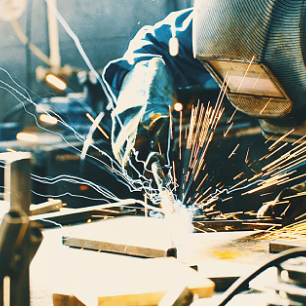Jump to:
3 Priorities for Welding Professionals to Build Resilience and Efficiency
For welding professionals, 2025 is proving to be a year of caution. Tariffs, fluctuating commodity prices, and broader economic uncertainty have delayed or paused many capital projects. Across industries, decision-makers are taking a wait-and-see approach before committing major resources.
While this pause can feel like a standstill, it’s also a critical window to prepare for what’s next. Welding and fabrication operations that use this time to strengthen their processes, train their workforce, and integrate emerging technologies will be better positioned when economic activity accelerates again.
Instead of focusing solely on short-term challenges, welding leaders can treat this period as an investment phase, laying the groundwork for cost savings, efficiency, and productivity that will pay off for years to come.
Three priorities stand out for organizations that want to make the most of this moment: advancing artificial intelligence (AI) and remote monitorization, committing to workforce development, and embracing sustainability to reduce waste and increase output.
Leverage AI and Remote Monitorization to Increase Uptime
AI has emerged as a practical tool for keeping operations running smoothly and minimizing costly downtime for welding professionals, especially those deploying robotic arc welding. Remote monitoring and predictive maintenance are two areas where AI is already delivering benefits.
In robotic welding applications, AI-powered systems can track robot health in real time and flag potential problems before interruptions occur. This means issues such as torch misalignment, gas flow disruptions, or wear on consumables can be identified and addressed quickly.
Remote monitorization takes this a step further. It can enable technicians to troubleshoot and update systems from miles away. This reduces the need for onsite intervention, shortens repair cycles, and keeps production lines running to maintain uptime.
According to a 2023 report from McKinsey & Co., predictive maintenance powered by AI can reduce machine downtime by up to 50% and extend equipment life by 20–40% (Ref. 1). For welding shops facing tighter budgets, these efficiencies directly translate into cost savings.
For operations managers, now is an ideal time to:
- Audit existing welding and robotic systems for opportunities to bring in emerging technologies.
- Explore AI-based weld monitoring software to improve bead quality and consistency.
- Build predictive maintenance protocols that keep uptime high and avoid unplanned stoppages.
When production demand ramps up again, organizations that have already modernized will be ready to scale quickly without being slowed by preventable breakdowns.
Double Down on Workforce Development
While economic pressures might tempt companies to cut back on training, this is precisely the wrong moment to scale back investment in people. Welding is facing a persistent skills gap. AWS cites a need for more than 320,500 welding professionals by 2029 (Ref. 2).
This skills gap goes beyond not having enough hands. The industry is experiencing an unprecedented shift that calls for employees who are skilled at navigating increasingly automated and technology-integrated workflows. Training programs that combine traditional welding expertise with robotic programming, data literacy, and AI use will create a more adaptable workforce capable of meeting future challenges.
Effective workforce development strategies during uncertain times include the following:
- Cross-training existing staff so they can work across multiple processes and systems.
- Building mentorship programs where experienced welders pass on both technical skills and safety best practices to newer workers.
- Integrating technology into training.
All of the above contribute positively to employee retention, promotional opportunities, and employee recruitment. Companies that maintain a steady focus on training now will be able to take on more complex and higher-margin projects when the economy strengthens without scrambling to hire and train at the last minute.
Commit to Sustainability for Cost and Productivity Gains
When welders hear the word sustainability, they often associate it with difficult workflows and processes, albeit with environmental responsibility. However, sustainability can be a powerful tool for cost control and productivity improvement.
Material waste, excessive scrap, and high consumable usage drive up costs and slow production. In times when budgets are being squeezed, reducing waste can have a direct impact on profitability.
Modern welding technologies, from advanced power sources to improved wire feeders, are helping shops achieve lower scrap rates and cleaner welds with less spatter. For example, high-deposition processes and controlled heat input techniques can minimize rework while real-time monitoring systems can detect quality issues before they require an entire part to be scrapped.
Beyond immediate cost savings, reducing scrap and waste positions operations for long-term competitiveness. Many end customers are now including sustainability metrics in their supplier evaluations. Demonstrating the ability to deliver high-quality welds with minimal waste can be a differentiator in winning contracts.
Key actions to consider include the following:
- Identifying and addressing sources of spatter and rework.
- Tracking consumable usage and implementing processes to reduce overconsumption.
- Incorporating lean manufacturing principles to minimize idle time and wasted movement.
As regulatory requirements regarding environmental impact tighten, welding operations that have already aligned with sustainable practices will avoid costly compliance scrambles.
Building a Stronger Foundation
Periods of uncertainty can feel like setbacks, but for welding professionals, they can be an opportunity to strengthen core capabilities and adopt tools and practices that will ensure long-term success.
By focusing on AI-driven monitorization, developing a skilled and adaptable workforce, and embracing sustainability as both a cost and quality strategy, welding leaders and welders alike can turn today’s caution into tomorrow’s competitive edge.
When the pace of capital projects picks up again, the organizations that invested in resilience will be ready to seize the moment with steady hands, sharper skills, and more efficient processes from the front door of the shop all the way to the dock.
References
McKinsey & Co. 2023. The State of AI in Manufacturing. Retrieved September 22, 2025, from
mckinsey.com.
American Welding Society. Workforce Data for Welding. Retrieved September 22, 2025, from
weldingworkforcedata.com.
SCOTT A. MAZZULLA (scott.mazzulla@us.panasonic.com) is manager, Welding and Robotics North America, Panasonic Connect, Hillard, Ohio.


